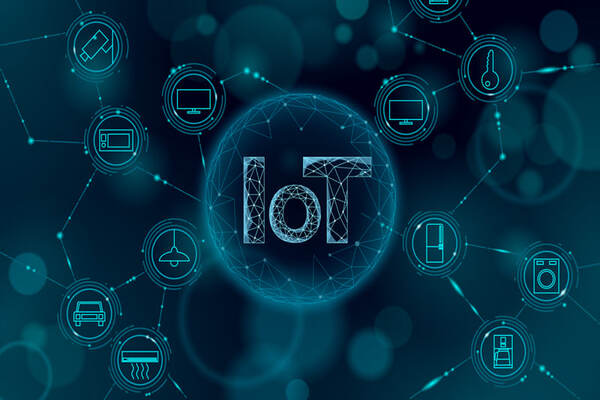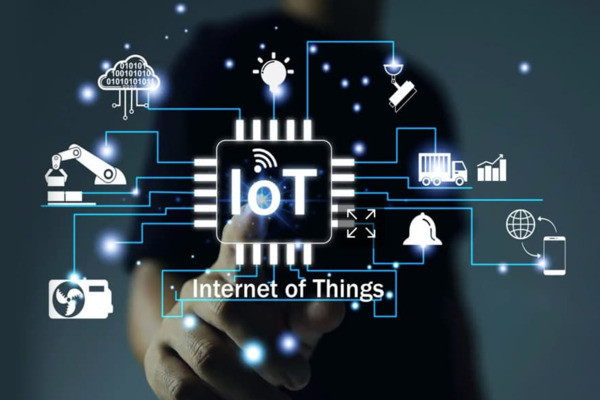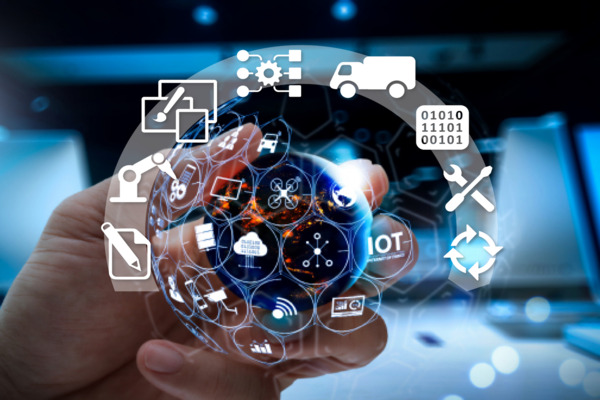In the digital era, the term “What is IoT?” (Internet of Things) is becoming increasingly common and an essential trend across all aspects of modern life. IoT is not just the concept of connecting devices to the Internet; it forms the foundation of a smart ecosystem where people can monitor, control, and optimize activities remotely. From homes, healthcare, and transportation to manufacturing, IoT is gradually transforming how we live, work, and interact with the world around us.
What is IoT?
IoT (Internet of Things) refers to a network of physical devices embedded with sensors, software, and Internet connectivity, enabling them to collect and exchange data. These “smart objects” include smartphones, smartwatches, cars, air conditioners, surveillance cameras, and even industrial machinery.

The core of IoT is its ability to allow devices to communicate automatically without human intervention, making processes smarter, saving time, and reducing costs. Simply put, IoT turns the physical world into a digital network where every object has its own “voice” and can interact and support each other through data. This serves as a crucial foundation for today’s Industry 4.0 revolution.
Origins and Development of IoT
The concept of the Internet of Things (IoT) was first mentioned in 1999 by Kevin Ashton, a British scientist working at the Auto-ID Laboratory at MIT. His idea originated from using RFID technology to manage supply chains more efficiently.
However, the roots of IoT actually go back further. In the 1980s, engineers at Carnegie Mellon University in the United States connected a vending machine to the Internet to monitor its drink inventory. This is considered the first IoT application in history.
By the 2000s, with the development of cloud computing, wireless networks, and inexpensive sensors, IoT entered a period of rapid growth. Smart devices such as TVs, phones, and connected cars emerged, ushering in the era of connected living.
Today, IoT is not only present in personal life but has expanded to agriculture, manufacturing, healthcare, education, energy, and smart cities, becoming an essential part of modern socio-economic infrastructure.
Structure and Operation of IoT Systems
An IoT system is more than just a few devices connected to the Internet. It is a multi-layered architecture that works together to collect, process, transmit, and respond to data.
The basic structure of an IoT system typically includes:
- Devices or Sensors: Elements that directly collect data from the environment or objects (e.g., temperature, light, humidity, motion).
- Network Connectivity: Enables devices to transmit data to servers via Wi-Fi, 4G/5G, Bluetooth, or protocols such as ZigBee, LoRa, and NB-IoT.
- IoT Platform: Where data is stored, analyzed, and converted into valuable information.
- User Interface: Provides a way to interact with, monitor, and control devices remotely through mobile apps or web interfaces.
The IoT operation follows a closed-loop process:
Data Collection → Data Transmission → Data Analysis → Feedback/Control
Through this process, IoT systems can operate autonomously and make intelligent decisions without constant human supervision.
Benefits of IoT for Businesses and Daily Life
IoT provides significant advantages for both business operations and everyday life.

For Businesses
- Optimizing production processes: Real-time data allows companies to monitor production lines, reduce errors, and increase productivity.
- Reducing operational costs: Early detection of technical issues minimizes maintenance time and expenses.
- Enabling smarter decision-making: Decisions are based on precise data analysis rather than intuition.
- Enhancing customer experience: Products and services can be personalized based on user behavior.
For Daily Life
- Smart homes: Automatically adjust lighting, temperature, and security systems.
- Wearable devices: Monitor health and provide alerts for abnormal conditions.
- Smart vehicles: Support autonomous driving and collision warnings.
From businesses to individuals, IoT is gradually transforming how we work, live, and interact with the world around us.
Advantages and Disadvantages of the Internet of Things
While IoT brings numerous benefits, it also has strengths and limitations that should be objectively considered.
Advantages
- Increases efficiency through automation and reduces errors.
- Saves energy, time, and operational costs.
- Provides real-time data to improve decision-making.
- Supports the creation of intelligent and user-friendly environments.
Disadvantages
- Security risks: Internet-connected devices are vulnerable to cyberattacks.
- Privacy concerns: Personal data can be misused.
- High initial investment: Systems require robust infrastructure and ongoing maintenance.
- Compatibility issues: Devices from different manufacturers may not always work together.
Balancing efficiency and safety is key to fully leveraging the power of IoT in practical applications.
Core Technologies Behind IoT
Behind the smooth operation of any IoT system is the integration of multiple advanced technologies. The following core technologies make IoT the “heart” of the connected world:
- Smart Sensors: Collect accurate data from the real environment.
- Wireless Connectivity: Wi-Fi, Bluetooth, 5G, ZigBee, or LPWAN enable fast and stable data transmission.
- Cloud Computing: Stores and processes large-scale data efficiently.
- Artificial Intelligence (AI) and Machine Learning: Enable the system to analyze, predict, learn autonomously, and make intelligent decisions.
- Blockchain: Enhances security and transparency in IoT data transmission.
- Edge Computing: Processes data at the source, reducing latency and saving bandwidth.
The synergy of these technologies provides a solid foundation for IoT, transforming it from a concept into practical applications across all fields.
Practical Applications of IoT in Daily Life
Today, IoT has penetrated various sectors, from homes and healthcare to industry and retail. Here are three notable applications demonstrating IoT’s power in modern life:
IoT in Smart Homes
IoT systems allow users to control home devices—such as lights, air conditioners, washing machines, and cameras—via simple smartphone operations. Additionally, IoT can learn household routines to automatically adjust lighting, temperature, or door locks for convenience and security.
IoT in Smart Healthcare
In healthcare, IoT enables remote patient monitoring. Wearable devices track heart rate, blood pressure, and blood sugar levels, sending real-time data to doctors. IoT also assists hospitals in managing medical equipment and predicting medication needs more accurately.

IoT in Retail and Supply Chains
IoT helps retail businesses monitor product conditions, manage inventory, and optimize supply chains. With RFID and GPS sensors, every product can be tracked and quality-checked throughout storage and distribution.
These examples show that IoT not only brings convenience but also reshapes entire operational systems, impacting the global economy at large.
Challenges and Solutions in Implementing IoT
Implementing IoT in practice involves numerous challenges, requiring clear strategies and robust technologies.
Main Challenges
- Security and Privacy: Personal and business data are vulnerable to cyberattacks if not properly encrypted.
- System Integration Issues: Devices from different vendors may not be compatible with each other.
- Lack of Skilled Workforce: Operating and analyzing IoT data requires specialized expertise.
- High Initial Investment: Particularly challenging for small and medium-sized enterprises.
Solutions
- Use open IoT platforms that support multiple protocols.
- Enhance data security with encryption, two-factor authentication, and regular updates.
- Apply AI and Edge Computing to process data locally, reducing infrastructure load.
- Train internal staff and collaborate with reputable technology partners.
By taking these measures, businesses can turn challenges into opportunities, leveraging IoT as a strategic competitive advantage.
How Businesses Should Approach and Apply IoT
To successfully implement IoT, companies need a long-term vision and a clear roadmap:
- Define clear objectives: Determine the purpose of IoT – to increase productivity, reduce costs, or improve customer service.
- Assess current capabilities: Evaluate existing technology infrastructure, personnel, and data resources.
- Choose the right platform: Prioritize solutions that are flexible, scalable, and secure.
- Conduct pilot projects: Start on a small scale to measure effectiveness before expanding gradually.
- Analyze IoT data: This is the “heart” of value creation, enabling data-driven decisions rather than intuition-based ones.
- Build a data-driven culture: Ensure that every decision is based on accurate, real-time IoT information.
This approach ensures that IoT is not just a technological implementation but a strategic tool for sustainable growth and innovation.
Future Trends in the Internet of Things (IoT)
The future of IoT is closely linked to the convergence of AI, 5G, Blockchain, and Big Data. This convergence will make IoT devices faster, smarter, and more secure.

Some notable trends over the next decade include:
- AI-Integrated IoT (AIoT): Devices capable of self-learning and decision-making without pre-programming.
- Smart Cities: Managing traffic, energy, waste, and public safety using IoT technologies.
- Smart Agriculture: Using IoT sensors to monitor soil, water, and weather conditions.
- Virtual Healthcare and Remote Monitoring: IoT enables 24/7 patient monitoring without hospitalization.
- Industry 4.0: IoT integrated with robotics, automation, and digital production lines.
Statistics indicate that by 2030, over 25 billion IoT devices will be in operation worldwide, creating a foundation for a fully connected, intelligent, and sustainable society.
Through this discussion, we gain a comprehensive understanding of what IoT is, how it operates, its benefits, applications, and future potential. The Internet of Things is not just a technology—it is a key that connects the physical and digital worlds, ushering in a new era of artificial intelligence, data, and automation.
